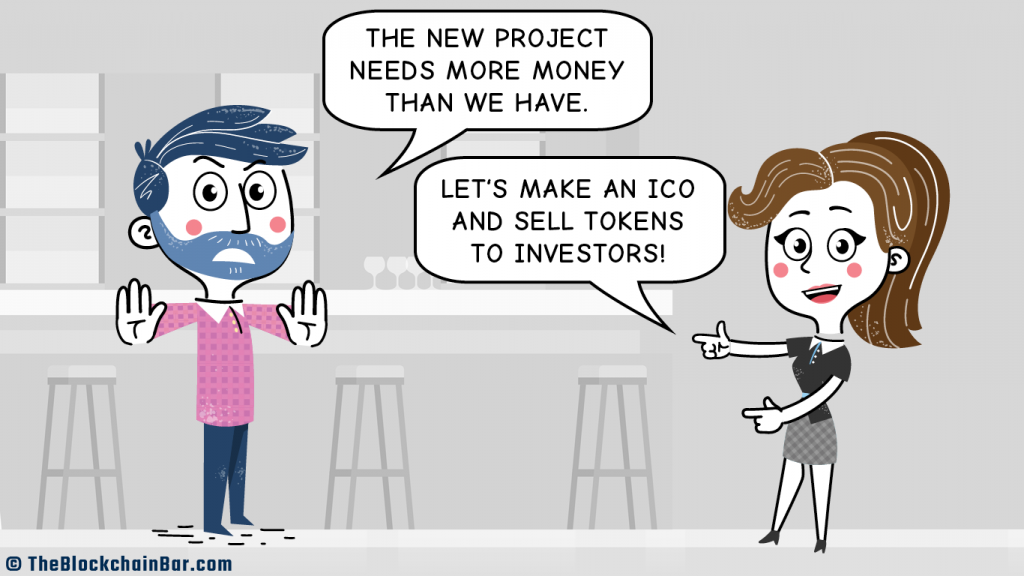Our friends at The Blockchain Bar want to open a new restaurant next to the Bar. They have to buy lots of equipment and renovate the place.
Oscar is desperate: “We need more money than we have! No money, no restaurant.”
Bob wonders: “The restaurant will make huge profits. How can we get money to invest?”
Alice has an idea: “Let’s create new tokens to pay for food once the restaurant is open! We can sell these tokens to future customers for a reduced price.”
Many patrons and neighbours of The Blockchain Bar believe in the plan and happily invest in the new tokens.
For several years, many blockchain projects have been raising millions of dollars by selling newly created crypto tokens to early investors. Bringing these tokens to the market is called ‘Initial Coin Offering’ or short: ICO.
Now that the team has enough money to invest, what are they gonna do? Find out in the next episode… which might come soon.
Until then, you can read much more about the blockchain at Blockruption.com.
But maybe you first want to read more about ICOs below.
Understanding Blockchain
Financing innovation and expansion with an ICO
The team of Blockruption’s Blockchain Bar decides to open a restaurant next to the Bar. But they don’t have the necessary money to invest. They need to renovate and equip the location, buy kitchen equipment, print a menu, and buy the ingredients for their meals. What can they do?
They want to run the restaurant like the Bar. Just like in the Bar, guests will pay their food with food tokens instead of normal money. The price of one meal will be about 10 euros. On average, you will need ten tokens per meal. So the normal price of a token will be around 1 euro.
To collect the required investment money up front, the team decides to ask their friends and future restaurant customers if they want to make an investment. They decide to sell some of the food tokens to the early investors before the start for a reduced price of 0.50 euro per token. As the team needs 50,000 euros to get started, they sell 100,000 tokens in advance.
When the restaurant opens, the early investors will have to pay 10 tokens per meal, just as all other customers. But unlike the normal guests who have to buy 10 tokens for 10 euros, they can use the early tokens they bought for just 5 euros per 10 tokens and eat for half the price.
Or they could sell the tokens to other customers. They will make a profit if they can get a price above the price they paid themselves, which was 0.50 euro. Other customers won’t be willing to pay more than 1 euro, because this is the regular price of a token. For example, if early investors sell at 0.75 euros per token they make a profit of 50%.
And if the early investors are lucky, the restaurant will be so popular that the demand for tokens is higher than expected. In this case the price for a token will increase to levels above the planned 1 euro, which would raise the investors’ profit even higher.
Very often people who want to start a new company don’t have enough money to get started. Before the blockchain was invented – and in many cases still today – company founders had to go to a bank to ask for credit.
It didn’t matter if they succeeded or failed, the bank always won. You had to pay back the loan even if the company went bankrupt.
It would be much better if you could ask investors who believe in your venture to invest some of their money. But going to the stock market and asking investors to buy shares is only an option for at least medium sized companies, because that is a complicated and expensive process.
The blockchain now offers an alternative that is similar to crowdfunding or the stock exchange but without any banks involved. It’s called initial coin offering (ICO).
With ICOs, teams can collect money to fund the development of a new blockchain network or a new application on an existing network. They write down what they plan to do in a so called ‘whitepaper’. In some cases they also provide a very basic prototype of the application they want to develop.
In the whitepaper they define a new kind of token that will be useful on the planned network. This could be, for example, a token for buying something like beer. Or a token to exchange neighbour services, e.g. I mow your lawn for 5 tokens. I then use 3 of those tokens to pay Bruce for singing at my child’s birthday party. When the network goes live, users who are new to the system will have to buy tokens for euros or dollars to get started.
After designing the token and its economy and writing the whitepaper the team offers to sell the tokens or ‘coins’ to early investors. For example, they decide to sell 10% of all tokens to be generated for a price of 1,000,000 euros to early investors.



